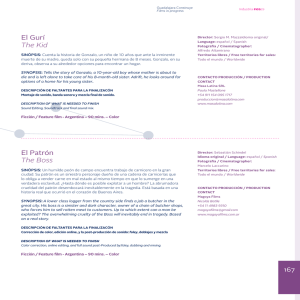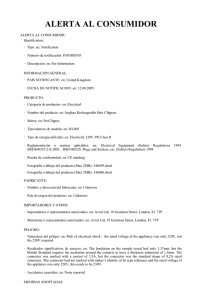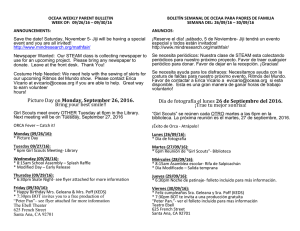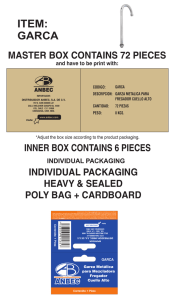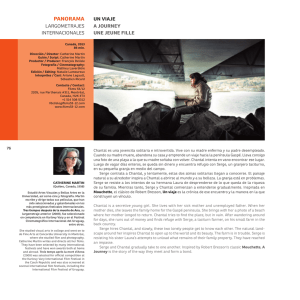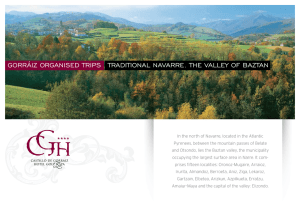Yanacocha SRL Mining Company Conga Project
Anuncio
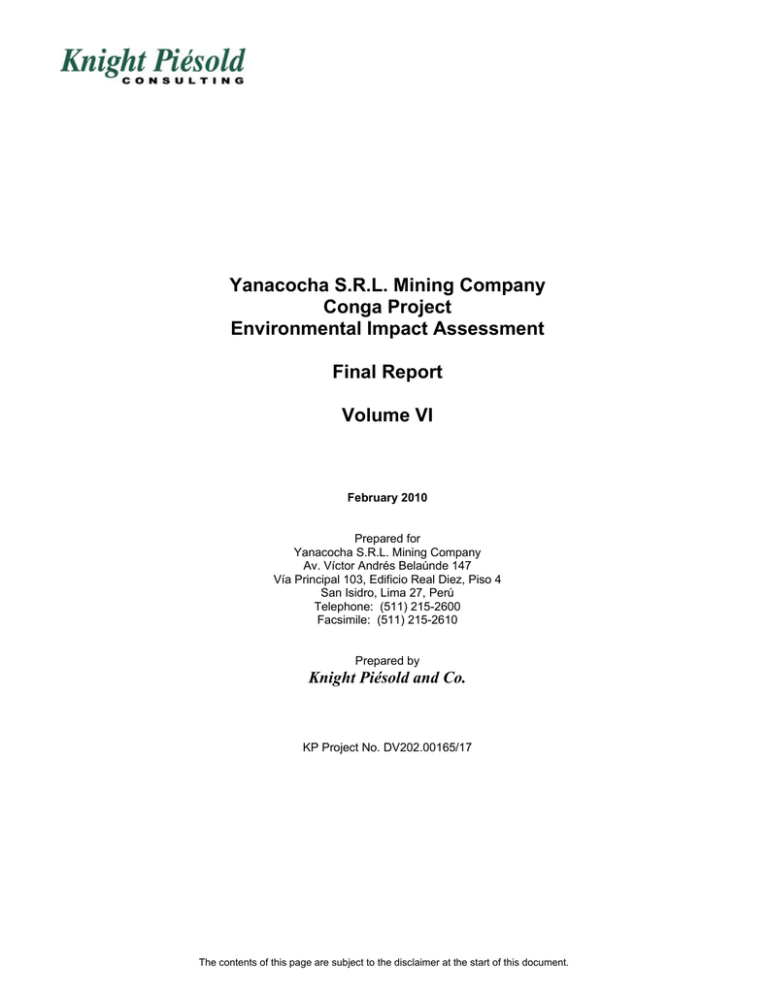
Yanacocha S.R.L. Mining Company Conga Project Environmental Impact Assessment Final Report Volume VI February 2010 Prepared for Yanacocha S.R.L. Mining Company Av. Víctor Andrés Belaúnde 147 Vía Principal 103, Edificio Real Diez, Piso 4 San Isidro, Lima 27, Perú Telephone: (511) 215-2600 Facsimile: (511) 215-2610 Prepared by Knight Piésold and Co. KP Project No. DV202.00165/17 The contents of this page are subject to the disclaimer at the start of this document. Table of Contents | Volume VI Photographs Photograph 3.2.1 Photograph 3.2.2 Photograph 3.2.3 Photograph 3.2.4 Photograph 3.2.5 Photograph 3.2.6 Photograph 3.2.7 Photograph 3.2.8 Photograph 3.2.9 Photograph 3.2.10 Photograph 3.2.11 Photograph 3.2.12 Photograph 3.2.13 Photograph 3.2.14 Photograph 3.2.15 Photograph 3.2.16 Photograph 3.2.17 Photograph 3.2.18 Photograph 3.2.19 Photograph 3.3.1 Photograph 3.3.2 Photograph 3.3.3 Photograph 3.3.4 Photograph 3.3.5 Photograph 3.3.6 Photograph 3.3.7 Photograph 3.3.8 Photograph 3.3.9 Photograph 3.3.10 Photograph 3.3.11 Photograph 3.3.12 Photograph 3.3.13 Photograph 3.3.14 Photograph 3.3.15 Photograph 3.3.16 Photograph 3.3.17 Photograph 3.3.18 Photograph 3.3.19 Photograph 3.3.20 Photograph 3.3.21 Photograph 3.3.22 Photograph 3.3.23 Landscape, fluvio-alluvial plain View from the top, alluvial valley bottom Coluvial-alluvial deposits sublandscape, Rio Grande river bed, Jadibamba River tributary Slightly sloped deposits sublandscape, Perol lake (or Lucmacocha) surrounding areas Low hill sublandscape of, top portion of Chailhuagon lake Volcanic rock mountain landscape, slope sublandscape, view from the road towards the Picota Grande hill. Volcanic rock mountain landscape, top Minas Conga hill sublandscape, Cortada lake Sedimentary rocks mountain landscape, superficially exposed rock, Taru Orco hill adjacent to Mamacocha lake Sedimentary rocks mountain landscape, top hills with undulating surfaces Chailhuagon Station MCEM-1 Huayra Machay Station MCEM-2 Água Blanca Station MCAB-1 Amaro Station MCAM-1 Huayra Machay Station MCHY-1 Montura Station MCMO-1 Ñun Ñun Quengorío Alto Station MCÑÑ-1 Perol Station MCPE-1 Quengorío Station MCQR-1 San Nicolas Station MCSN-1 Vegetation formation: scrubland –Mamacocha Area Vegetation formation: bog –Perol Bog Vegetation formation: agriculture – Eucalyptus Forest Vegetation formation: lake shoreline vegetation –Chailhuagon area Vegetation formation: lake shoreline vegetation - Mamacocha Vegetation formation: lake shoreline vegetation - Mishacocha Vegetation formation: rocky place –Alto Jadibamba Area Vegetation formation: puyal (Puya hamata) –Jadibamba Area Bromelliaceae (Puya hamata) –Alto Jadibamba area Bromelliaceae (Puya hamata) –Alto Jadibamba area Melastomataceae (Brachyotum naudinii) –Alto Chirimayo area Betulaceae (Alnus acuminata) –Alto Chirimayo area Apiaceae (Azorella crenata) –Alto Chirimayo, Toromacho, Chailhuagon and Alto Jadibamba areas Apiaceae (Daucus montanus) –Alto Chirimayo and Chailhuagon areas Apiaceae (Eryngium humile) –Alto Chirimayo, Toromacho, Chailhuagon, and Alto Jadibamba areas Ephedraceae (Ephedra rupestris) –Alto Chirimayo and Toromacho areas Asteraceae (Baccharis caespitosa) –Alto Chirimayo, Toromacho, Chailhuagon and Alto Jadibamba areas Fabaceae (Otholobium muyensis) –Alto Chirimayo and Chailhuagon Areas Asteraceae (Pappobolus lanatus) –Toromacho area Buddlejaceae (Buddleja longifolia) –Alto Chirimayo area Asteraceae (Wernaria pumila) –Alto Chirimayo, Toromacho and Chailhuagon areas Asteraceae (Werneria nubigena) –Alto Chirimayo, Toromacho, Chailhuagon and Alto Jadibamba areas Berberidaceae (Berberis saxicola) –Alto Jadibamba area The contents of this page are subject to the disclaimer at the start of this document. Photograph 3.3.24 Photograph 3.3.25 Photograph 3.3.26 Photograph 3.3.27 Photograph 3.3.28 Photograph 3.3.29 Photograph 3.3.30 Photograph 3.3.31 Photograph 3.3.32 Photograph 3.3.33 Photograph 3.3.34 Photograph 3.3.35 Photograph 3.3.36 Photograph 3.3.37 Photograph 3.3.38 Photograph 3.3.39 Photograph 3.3.40 Photograph 3.3.41 Photograph 3.3.42 Photograph 3.3.43 Photograph 3.3.44 Photograph 3.3.45 Photograph 3.3.46 Photograph 3.3.47 Photograph 3.3.48 Photograph 3.3.49 Photograph 3.3.50 Photograph 3.3.51 Photograph 3.3.52 Photograph 3.3.53 Photograph 3.3.54 Photograph 3.3.55 Photograph 3.3.56 Photograph 3.3.57 Photograph 3.3.58 Photograph 3.3.59 Photograph 3.3.60 Photograph 3.3.61 Photograph 3.3.62 Photograph 3.3.63 Photograph 3.3.64 Photograph 3.3.65 Photograph 3.3.66 Photograph 3.3.67 Photograph 3.3.68 Photograph 3.3.69 Photograph 3.3.70 Photograph 3.3.71 Photograph 3.3.72 Photograph 3.3.73 Photograph 3.3.74 Photograph 3.3.75 Buddlejaceae (Buddleja incana) –Chailhuagon area Cactaceae (Opuntia sp.) –Toromacho area Crassulaceae (Villadia incarum) –Toromacho area Cyperaceae (Carex pichinchensis) –Alto Chirimayo, Toromocho, Chailhuagon and Alto Jadibamba areas Ericaceae (Pernettya prostrata) –Alto Chirimayo, Toromacho, Chailhuagon and Alto Jadibamba areas Gentianaceae (Gentiana sedifolia) –Alto Jadibamba area Hypericaceae (Hypericum laricifolium) –Alto Jadibamba area Loasaceae (Nasa ranuncutifolia) –Toromacho area Lycopodiaceae (Huperzia crassa) –Alto Chirimayo and Alto Jadibamba areas Avifauna Surveys performed based on photographic manuals Live specimen traps Live specimen trap location Mist net deployment, wet season Bog water canal sampling - Chailhuagon Area Evaluation parcel sampling Fall trap installation Fall traps Furnariidae (Cinclodes fuscus) - Chailhuagon Area Furnariidae (Asthenes flammulata) - Chailhuagon Lake Notiochelidon murin - Chailhuagon Area Rallidae (Pardirallus sanguinolentus) - Chailhuagon Area Emberizidae (Phrygilus plebejus) –Alto Chirimayo (Perol bog) Area Motacillidae (Anthus bogotensis) –Alto Chirimayo Area Furnariidae (Asthenes humilis) –Alto Chirimayo Area Furnariidae (Cinclodes fuscus) –Alto Chirimayo Area Scolopacidae (Gallinago andin) –Alto Chirimayo Area Charadriidae (Vanellus resplendes) –Alto Chirimayo Area Zonotrichia capensis –Alto Chirimayo Area Trochilidae (Oreotrochilus estella) –Alto Jadibamba Area Female Emberizidae (Phrygilus unicolor) –Alto Jadibamba Area Furnariidae (Cinclodes atacamensis) - Toromacho Area Motacillidae (Anthus bogotensis) - Toromacho Area Emberizidae (Phrygilus plebejus) - Toromacho Area Female Emberizidae (Phrygilus unicolor) - Toromacho Area Furnariidae (Upucerthia jelski) - Toromacho Area Emberizidae (Zonotrichia capensis) - Toromacho Area Tyrannidae (Anairetes nigrocristatus) Trochilidae (Colibri coruscans) Trochilidae (Patagona gigas) Akodon mollis Conepatus sp. Male Petracola ventrimaculatus. (a) dorsal and (b) ventral views Petracola ventrimaculatus. (a) Female Individual. (b) Eggs Stenocercus sp. Male Individual in (a) dorsal and (b) ventral views Stenocercus sp. (a) Female Individual. (b) Eggs Gastrotheca monticola Coloring variation of the Gastrotheca monticola Eleutherodactylus pinguis Eleutherodactylus simonsii. (a) Dorsal lateral view. (b) Ventral View Gastrotheca monticola tadpoles (a) swimming in an artificial pond at hill bottom. (b) Tadpole lateral view (a) Female Gastrotheca monticola with eggs. (b) View of marsupial, entrance Lepidoptera larvae, Noctuidae Family (Gen. Agrotis sp.) The contents of this page are subject to the disclaimer at the start of this document. Photograph 3.3.76 Photograph 3.3.77 Photograph 3.3.78 Photograph 3.3.79 Photograph 3.3.80 Photograph 3.3.81 Photograph 3.3.82 Photograph 3.3.83 Photograph 3.3.84 Photograph 3.3.85 Photograph 3.3.86 Photograph 3.3.87 Photograph 3.3.88 Photograph 3.3.89 Photograph 3.3.90 Photograph 3.3.91 Photograph 3.3.92 Photograph 3.3.93 Photograph 3.3.94 Photograph 3.4.1 Photograph 3.4.2 Photograph 3.4.3 Photograph 3.4.4 Photograph 3.4.5 Photograph 3.4.6 Photograph 3.4.7 Photograph 3.4.8 Photograph 3.4.9 Photograph 3.4.10 Photograph 3.4.11 Photograph 3.4.12 Photograph 3.4.13 Photograph 3.4.14 Photograph 3.4.15 Photograph 3.4.16 Photograph 3.4.17 Photograph 3.4.18 Photograph 3.4.19 Photograph 3.4.20 Photograph 3.4.21 Photograph 3.4.22 Coleoptera, Scarabaeidae Family Coleoptera: Lapyridae (Glowworms) Phasmatoptera, (walkingstick) Hemiptera Cicadellidae Hymenoptera Braconidae Hymenoptera Ichneumonidae Coleoptera Scarabaeidae Lepidoptera Saturnidae Coleoptera Staphylinidae parasitizing a mouse Anacroneuria Gender (Perlidae, Plecoptera) Thoracic Gills diposition in the Anacroneuria sp. Anomalocosmoecus Gender(Limnephilidae, Trichoptera) Characteristic Habitus of the Limnephilidae Family (Trichoptera) Genus front-lateral view, head distinguishable (Anomalocosmoecus sp generic taxonomic type) Characteristic habitus, Chironomidae family, Chironominae subfamily (Diptera) Characteristic habitus, Leptophlebiidae family Austrelmis sp. Adult and larva habitus, observe lateral ridge in adult pronotum (generic type), (Elmidae, Coleoptera) Orthocladiinae subfamily larvae (Chironomidae, Diptera) Tanypodinae Larvae (Chironomidae, Diptera) Scrubland and rocky landscape, Mamacocha lake surroundings, Stone Crocodile Scrubland and uncovered soils landscape, Taru Orco Hill Panoramic view from Alumbre hill, scrublands and cultivation areas can be observed Panoramic view, area’s low portion. Similar to Polonia hill outcroppings and cultivation areas landscape Panoramic view, scrubland landscape, Quengorío Bajo village can be seen in the back Panoramic view, Polonia Hill and Quengorío Bajo village Panoramic view, Mojon Hill Panoramic view, Blanca ravine, aboriginal queñual hills Panoramic view, Taru Orco,Toro, Vaca hills towards the future tailings storage facility dam Panoramic view from the road, Toro and Vaca hills, towards a branch of the future tailings storage facility dam Panoramic view, Azul lake, area to be used for Perol waste dump Panoramic view, Cortada lake and Lluspioc hill View towards the Huayra Machay hill, where topsoil stockpile Nº2 will be developed Panoramic view, burnt areas near the area that will be used for Perol waste dump Panoramic view from the Huamangaga Hill towards Perol waste dump and tailings storage facility areas Panoramic view from the Huamangaga hill towards Cortada lake, Minas Conga and Lluspioc hills From the road, at future tailings storage facility area area including view of Cardon Loma hill From Chugurmayo and Alto Jadibamba watershed, Huamanga and Minas Conga Hills can be observed, along with Picota Grande hill in the background Panoramic view, Chugurmayo Area surrounded by Minas Conga, Huamanga, and Cocañes hills Area panoramic view, Lindero, Alumbre and Minas Conga hills can be observed, Picota Grande in the background- 44 View of Cocañes, Huamanga, and Picota Grande Hills From the road, towards Alto Chirimayo ravine valley’s bottom, Cocañes, Picota Grande, Perol hills can be observed along with the Huashwas lake, and Azul Conga hillside The contents of this page are subject to the disclaimer at the start of this document. Photograph 3.4.23 Panoramic view, bogs and Perol lake and Cocañes and Picota Grande hills Photograph 3.4.24 Panoramic view, bog, Cocañes, Picota Grande, Perol, Azul Conga and Huayra Machay hills can be observed. Perol lake can be observed in the background. Area where Perol Pit will be developed Photograph 3.4.25 View, Picota Grande, Chica and Perol Hills, El Tingo fields in background Photograph 3.4.26 Panoramic view towards Chailhuagon hill, Fierruyoc hill in background. Area that will be used for Chailhuagon waste dump Photograph 3.4.27 Panoramic view, Agua Blanca village at Alto Chirimayo ravine, Perol, Picota Chica, Ojo de Agua and Quishuar Conga Hills Photograph 3.4.28 Panoramic view, Chica lake from Quishuar Conga hill; Muchacha Mishacocha, and Azul Conga hills can be seen, which form a visual barrier towards the Alforja Cocha lake Photograph 3.4.29 Panoramic view from the road that crosses Ojo de Agua hill, towards El Tingo; the Peña Blanca, Tomo, Quishuar Conga, and Muchacha hills at the in background Photograph 3.4.30 Panoramic view, Agua Blanca, Alto Chirimayo ravine, surrounded by Perol, Picota Chica and Azul Conga Hills Photograph 3.4.31 Panoramic view from bottom of Picota Grande Hill towards Empedrada lake; El Porvenir school, Chailhuagon, and Huayra Machay hills can be seen. Perol Pit will be developed in this area. Photograph 3.4.32 From the road, towards bottom of valley where Chailhuagon Pit will be developed Photograph 3.4.33 From the road, Chailhuagon lake Photograph 3.4.34 Panoramic view from bottom of ravine, towards Pencayoc and Fierruyoc hills Photograph 3.4.35 Panoramic view, Chailhuagon hill and San Nicolas community Photograph 3.4.36 Panoramic view towards Quinua Pampa hill and Chailhuagon hill in background Photograph 3.4.37 Panoramic view towards San Juan Hierba Buena village Photograph 3.4.38 Panoramic view, Mishacocha and Quinua Pampa hills Photograph 3.4.39 Panoramic view from Hierba Buena toward Pillucnioc ravine, and the Mishacoha and Quinua Pampa hills, Chailhuagon hill in background Photograph 3.4.40 Panoramic view, Huachua and Collpa Conga hills, Chailhuagon hill in background Photograph 3.4.41 Panoramic view from El Porvenir school, hills view Photograph 3.4.42 Peña Blanca and El Alumbre ravines, and Mojon hill Photograph 3.4.43 Sedimentary rock mountain landscape, superficially exposed rock at Taru Orco hill adjacent to Mamacocha lake Photograph 3.4.44 Cattle areas, Taru Orco hill Photograph 3.4.45 Outcroppings, Polonia hill top Photograph 3.4.46 Polonia hill–Polonia La Collpa community Photograph 3.4.47 El Alumbre community –Alumbre hill Photograph 3.4.48 Quengorío Alto Photograph 3.4.49 Quengorío Alto school Photograph 3.4.50 Quengorío Bajo Photograph 3.4.51 House in the top portion of El Alumbre ravine Photograph 3.4.52 Houses in the northern portion area, near basin watersheds Photograph 3.4.53 Panoramic view, Taru Orco hill Photograph 3.4.54 Wind energy Photograph 3.4.55 Azul lake, puya Photograph 3.4.56 Cortada lake Photograph 3.4.57 Río Grande River, Cardon Loma and Peña de León hills Photograph 3.4.58 Sombreruyoc hills and Pampa Jadibamba Photograph 3.4.59 Río Grande River, Cardon Loma and Mojon hills, future tailings storage facility dam Photograph 3.4.60 Burning fields, Minas Conga hill Photograph 3.4.61 Outcropping, Pampa Jadibamba, Río Grande river Photograph 3.4.62 Mojon hill coverage, Río Grande River, tailings storage facility canal Photograph 3.4.63 Lluspioc Hill Photograph 3.4.64 Huasiyuc School Photograph 3.4.65 Huasiyuc House The contents of this page are subject to the disclaimer at the start of this document. Photograph 3.4.66 Photograph 3.4.67 Photograph 3.4.68 Photograph 3.4.69 Photograph 3.4.70 Photograph 3.4.71 Photograph 3.4.72 Photograph 3.4.73 Photograph 3.4.74 Photograph 3.4.75 Photograph 3.4.76 Photograph 3.4.77 Photograph 3.4.78 Photograph 3.4.79 Photograph 3.4.80 Photograph 3.4.81 Photograph 3.4.82 Photograph 3.4.83 Cattle, Huasiyuc Piedras Grandes, Cattle Horse, Piedras Grandes village House and field, Agua Blanca, Chirimayo ravine surroundings House, La Pacha village Cattle, upstream, Chirimayo ravine Sheep on its way to Potrerillo village Chailhuagon lake Burning fields San Nicolás of Chailhuagon Homes under Chailhuagon hill El Porvenir school San Juan of Hierba Buena Hierba Buena Chica I Hierba Buena Chica II Hierba Buena Chica III House and cattle, upstream, Chailhuagon lake ravine confluence Cattle, San Nicolás village The contents of this page are subject to the disclaimer at the start of this document. Photographs The contents of this page are subject to the disclaimer at the start of this document. Fotografía 3.2.1: Gran paisaje planicie fluvio aluvial. Fotografía 3.2.2: Vista de la parte superior del subpaisaje de fondo de valle aluvial. The contents of this page are subject to the disclaimer at the start of this document. Fotografía 3.2.3: Subpaisaje de depósitos coluvio aluviales en el cauce del río Grande, afluente del río Jadibamba. Fotografía 3.2.4: Subpaisaje de depósitos ligeramente inclinados, en las cercanías de la laguna Perol (o Lucmacocha). The contents of this page are subject to the disclaimer at the start of this document. Fotografía 3.2.5: Subpaisaje de colinas bajas, parte alta de la laguna Chailhuagón. Fotografía 3.2.6: Paisaje de montañas de rocas volcánicas, subpaisaje de laderas vista desde la carretera hacia el cerro Picota Grande. The contents of this page are subject to the disclaimer at the start of this document. Fotografía 3.2.7: Paisaje de montañas de rocas volcánicas, subpaisaje de cimas en el cerro Minas Conga, laguna Cortada. Fotografía 3.2.8: Paisaje de montañas de rocas sedimentarias, roca expuesta superficialmente en el cerro Taruorco colindante con la laguna Mamacocha. The contents of this page are subject to the disclaimer at the start of this document. Fotografía 3.2.9: Paisaje de montaña de rocas sedimentarias, colinas de cimas con superficies onduladas. The contents of this page are subject to the disclaimer at the start of this document. Fotografía 3.2.10: Estación Chailhuagón MCEM-1 Fotografía 3.2.11: Estación Huayra Machay MCEM-2 The contents of this page are subject to the disclaimer at the start of this document. Fotografía 3.2.12: Estación Agua Blanca MCAB-1 Fotografía 3.2.13: Estación Amaro MCAM-1 The contents of this page are subject to the disclaimer at the start of this document. Fotografía 3.2.14: Estación Huayra Machay MCHY-1 Fotografía 3.2.15: Estación Montura MCMO-1 The contents of this page are subject to the disclaimer at the start of this document. Fotografía 3.2.16: Estación Ñun Ñun Quengorío Alto MCÑÑ-1 Fotografía 3.2.17: Estación Perol MCPE-1 The contents of this page are subject to the disclaimer at the start of this document. Fotografía 3.2.18: Estación Quengorío MCQR-1 Fotografía 3.2.19: Estación San Nicolás MCSN-1 The contents of this page are subject to the disclaimer at the start of this document. Fotografía 3.3.1: Formación vegetal: pajonal – Sector Mamacocha Fotografía 3.3.2: Formación vegetal: bofedal – Bofedal Perol The contents of this page are subject to the disclaimer at the start of this document. Fotografía 3.3.3: Formación vegetal: agricultura – Bosque de eucalipto Fotografía 3.3.4: Formación vegetal: vegetación de orilla de laguna – Sector Chailhuagón The contents of this page are subject to the disclaimer at the start of this document. Fotografía 3.3.5: Formación vegetal: vegetación de orilla de laguna - Mamacocha Fotografía 3.3.6: Formación vegetal: vegetación de orilla de laguna - Mishacocha The contents of this page are subject to the disclaimer at the start of this document. Fotografía 3.3.7: Formación vegetal: roquedal – Sector Alto Jadibamba Fotografía 3.3.8: Formación vegetal: puyal (Puya hamata) – Sector Alto Jadibamba The contents of this page are subject to the disclaimer at the start of this document. Fotografía 3.3.9: Bromelliaceae (Puya hamata) – Sector Alto Jadibamba Fotografía 3.3.10: Bromelliaceae (Puya hamata) – Sector Alto Jadibamba The contents of this page are subject to the disclaimer at the start of this document. Fotografía 3.3.11: Melastomataceae (Brachyotum naudinii) – Sector Alto Chirimayo Fotografía 3.3.12: Betulaceae (Alnus acuminata) – Sector Alto Chirimayo The contents of this page are subject to the disclaimer at the start of this document. Fotografía 3.3.13: Apiaceae (Azorella crenata) – Sectores Alto Chirimayo, Toromacho, Chailhuagón y Alto Jadibamba Fotografía 3.3.14: Apiaceae (Daucus montanus) – Sectores Alto Chirimayo y Chailhuagón The contents of this page are subject to the disclaimer at the start of this document. Fotografía 3.3.15: Apiaceae (Eryngium humile) – Sectores Alto Chirimayo, Toromacho, Chailhuagón, Alto Jadibamba Fotografía 3.3.16: Ephedraceae (Ephedra rupestris) – Sectores Alto Chirimayo y Toromacho The contents of this page are subject to the disclaimer at the start of this document. Fotografía 3.3.17: Asteraceae (Baccharis caespitosa) – Sectores Alto Chirimayo, Toromacho, Chailhuagón y Alto Jadibamba Fotografía 3.3.18: Fabaceae (Otholobium muyensis) – Sectores Alto Chirimayo y Chailhuagón The contents of this page are subject to the disclaimer at the start of this document. Fotografía 3.3.19: Asteraceae (Pappobolus lanatus) –Sectores Toromacho Fotografía 3.3.20: Buddlejaceae (Buddleja longifolia) – Sectores Alto Chirimayo The contents of this page are subject to the disclaimer at the start of this document. Fotografía 3.3.21: Asteraceae (Wernaria pumila) – Sectores Alto Chirimayo, Toromacho y Chailhuagón Fotografía 3.3.22: Asteraceae (Werneria nubigena) – Sectores Alto Chirimayo, Toromacho, Chailhuagón y Alto Jadibamba The contents of this page are subject to the disclaimer at the start of this document. Fotografía 3.3.23: Berberidaceae (Berberis saxicola) – Sector Alto Jadibamba Fotografía 3.3.24: Buddlejaceae (Buddleja incana) – Sector Chailhuagón The contents of this page are subject to the disclaimer at the start of this document. Fotografía 3.3.25: Cactaceae (Opuntia sp.) – Sector Toromacho Fotografía 3.3.26: Crassulaceae (Villadia incarum) – Sector Toromacho The contents of this page are subject to the disclaimer at the start of this document. Fotografía 3.3.27: Cyperaceae (Carex pichinchensis) – Sectores Alto Chirimayo, Toromocho, Chailhuagón y Alto Jadibamba Fotografía 3.3.28: Ericaceae (Pernettya prostrata) – Sectores Alto Chirimayo, Toromacho, Chailhuagón y Alto Jadibamba The contents of this page are subject to the disclaimer at the start of this document. Fotografía 3.3.29: Gentianaceae (Gentiana sedifolia) – Sector Alto Jadibamba Fotografía 3.3.30: Hypericaceae (Hypericum laricifolium) – Sector Alto Jadibamba The contents of this page are subject to the disclaimer at the start of this document. Fotografía 3.3.31: Loasaceae (Nasa ranuncutifolia) – Sector Toromacho Fotografía 3.3.32: Lycopodiaceae (Huperzia crassa) – Sectores Alto Chirimayo y Alto Jadibamba The contents of this page are subject to the disclaimer at the start of this document. Fotografía 3.3.33: Encuestas realizadas sobre la avifauna con manuales fotográficos The contents of this page are subject to the disclaimer at the start of this document. Fotografía 3.3.34. Trampa para captura de especímenes vivos Fotografía 3.3.35. Ubicación de trampas para captura de especímenes vivos The contents of this page are subject to the disclaimer at the start of this document. Fotografía 3.3.36. Despliegue de las redes de neblina en época de lluvias. The contents of this page are subject to the disclaimer at the start of this document. Fotografía 3.3.37: Muestreo de canal de agua en bofedal - Sector Chailhuagón. Fotografía 3.3.38: Muestreo en parcela de evaluación The contents of this page are subject to the disclaimer at the start of this document. Fotografía 3.3.39: Instalación de las trampas de caída. Fotografía 3.3.40: Trampas de caída. The contents of this page are subject to the disclaimer at the start of this document. Fotografía 3.3.41: Furnariidae (Cinclodes fuscus) - Sector Chailhuagón Fotografía 3.3.42: Furnariidae (Asthenes flammulata) - Laguna Chailhuagón The contents of this page are subject to the disclaimer at the start of this document. Fotografía 3.3.43: Notiochelidon murin - Sector Chailhuagón Fotografía 3.3.44: Rallidae (Pardirallus sanguinolentus) - Sector Chailhuagón, habita en los totorales que rodean a la laguna The contents of this page are subject to the disclaimer at the start of this document. Fotografía 3.3.45: Emberizidae (Phrygilus plebejus) – Sector Alto Chirimayo (bofedal Perol) Fotografía 3.3.46: Motacillidae (Anthus bogotensis) – Sector Alto Chirimayo The contents of this page are subject to the disclaimer at the start of this document. Fotografía 3.3.47: Furnariidae (Asthenes humilis) – Sector Alto Chirimayo Fotografía 3.3.48: Furnariidae (Cinclodes fuscus) – Sector Alto Chirimayo The contents of this page are subject to the disclaimer at the start of this document. Fotografía 3.3.49: Scolopacidae (Gallinago andin) – Sector Alto Chirimayo Fotografía 3.3.50: Charadriidae (Vanellus resplendes) – Sector Alto Chirimayo The contents of this page are subject to the disclaimer at the start of this document. Fotografía 3.3.51: Zonotrichia capensis – Sector Alto Chirimayo Fotografía 3.3.52: Trochilidae (Oreotrochilus estella) – Sector Alto Jadibamba The contents of this page are subject to the disclaimer at the start of this document. Fotografía 3.3.53: Emberizidae hembra (Phrygilus unicolor) – Sector Alto Jadibamba Fotografía 3.3.54: Furnariidae (Cinclodes atacamensis) - Sector Toromacho The contents of this page are subject to the disclaimer at the start of this document. Fotografía 3.3.55: Motacillidae (Anthus bogotensis) - Sector Toromacho Fotografía 3.3.56: Emberizidae (Phrygilus plebejus) - Sector Toromacho The contents of this page are subject to the disclaimer at the start of this document. Fotografia 3.3.57: Emberizidae hembra (Phrygilus unicolor) - Sector Toromacho Fotografía 3.3.58: Furnariidae (Upucerthia jelski) - Sector Toromacho The contents of this page are subject to the disclaimer at the start of this document. Fotografía 3.3.59: Emberizidae (Zonotrichia capensis) - Sector Toromacho Fotografía 3.3.60: Tyrannidae (Anairetes nigrocristatus) The contents of this page are subject to the disclaimer at the start of this document. Fotografía 3.3.61: Trochilidae (Colibri coruscans) Fotografía 3.3.62: Trochilidae (Patagona gigas) The contents of this page are subject to the disclaimer at the start of this document. Fotografía 3.3.63: Akodon mollis Fotografía 3.3.64: Conepatus sp. The contents of this page are subject to the disclaimer at the start of this document. a) b) Fotografías 3.3.65: Petracola ventrimaculatus macho. Vista (a) dorsal y (b) ventral. The contents of this page are subject to the disclaimer at the start of this document. a) b) Fotografía 3.3.66: Petracola ventrimaculatus. (a) Individuo hembra. (b) Huevos. The contents of this page are subject to the disclaimer at the start of this document. a) b) Fotografía 3.3.67: Stenocercus sp. Individuo macho en vista (a) dorsal y (b) ventral. The contents of this page are subject to the disclaimer at the start of this document. a) b) Fotografía 3.3.68: Stenocercus sp. (a) Individuo hembra. (b) Huevos. The contents of this page are subject to the disclaimer at the start of this document. Fotografía 3.3.69: Gastrotheca monticola. Fotografía 3.3.70: Variación de la coloración de Gastrotheca monticola. The contents of this page are subject to the disclaimer at the start of this document. Fotografía 3.3.71: Eleutherodactylus pinguis. The contents of this page are subject to the disclaimer at the start of this document. a) b) Fotografía 3.3.72: Eleutherodactylus simonsii. (a) Vista dorsolateral. (b) Vista ventral. The contents of this page are subject to the disclaimer at the start of this document. a) b) Fotografía 3.3.73: Renacuajos de Gastrotheca monticola. (a) Nadando en una charca artificial al pie de un cerro. (b) Vista lateral del renacuajo. The contents of this page are subject to the disclaimer at the start of this document. a) b) Fotografía 3.3.74: (a) Gastrotheca monticola hembra con huevos. (b) Vista de la entrada del marsupio The contents of this page are subject to the disclaimer at the start of this document. Fotografía 3.3.75: Larvas de Lepidoptera, Familia Noctuidae (Gen. Agrotis sp.). Fotografía 3.3.76: Coleoptera, Familia Scarabaeidae The contents of this page are subject to the disclaimer at the start of this document. Fotografía 3.3.77: Coleoptera: Lapyridae (Luciérnagas) Fotografía 3.3.78: Phasmoptera, (Insecto palo). The contents of this page are subject to the disclaimer at the start of this document. Fotografía 3.3.79: Hemiptera Cicadellidae Fotografía 3.3.80: Hymenoptera Braconidae The contents of this page are subject to the disclaimer at the start of this document. Fotografía 3.3.81: Hymenoptera Ichneumonidae Fotografía 3.3.82: Coleoptera Scarabaeidae The contents of this page are subject to the disclaimer at the start of this document. Fotografía 3.3.83: Lepidoptera Saturnidae. Fotografía 3.3.84: Coleoptera Staphylinidae parasitando un ratón. The contents of this page are subject to the disclaimer at the start of this document. Fotografía 3.3.85: Género Anacroneuria (Perlidae, Plecoptera). The contents of this page are subject to the disclaimer at the start of this document. Fotografía 3.3.86: Disposición de las branquias toráxicas en Anacroneuria sp. The contents of this page are subject to the disclaimer at the start of this document. Fotografía 3.3.87: Género Anomalocosmoecus (Limnephilidae, Trichoptera). The contents of this page are subject to the disclaimer at the start of this document. Fotografía 3.3.88: Habitus característico de la familia Limnephilidae (Trichoptera), nótese las denominadas uñas anales (característica del orden) en la porción terminal del abdomen. The contents of this page are subject to the disclaimer at the start of this document. Fotografía 3.3.89: Carena fronto-lateral distinguible en la cabeza (carácter taxonómico genérico de Anomalocosmoecus sp.). Fotografía 3.3.90: Habitus característico, familia Chironomidae, subfamilia Chironominae (Diptera). The contents of this page are subject to the disclaimer at the start of this document. Fotografía 3.3.91: Habitus característico, familia Leptophlebiidae. The contents of this page are subject to the disclaimer at the start of this document. Fotografía 3.3.92: Austrelmis sp. habitus de adulto y larva, nótese la carena lateral en el pronotum del adulto (carácter genérico), (Elmidae, Coleoptera). The contents of this page are subject to the disclaimer at the start of this document. Fotografía 3.3.93: Larvas de la subfamilia Orthocladiinae (Chironomidae, Diptera) Fotografía 3.3.94: Larvas de Tanypodinae (Chironomidae, Diptera) The contents of this page are subject to the disclaimer at the start of this document. Fotografía 3.4.1: Paisaje de Pajonal y Roquerio en las inmediaciones de la Laguna Mamacocha, Cocodrilo de Piedra Fotografía 3.4.2: Paisaje de Pajonal y suelos descubiertos en el cerro Taru Orco The contents of this page are subject to the disclaimer at the start of this document. Fotografía 3.4.3: Vista panorámica desde el cerro Alumbre, se observa paisajes de Pajonales y Zonas de Cultivo Fotografía 3.4.4: Vista panorámica de la parte baja del sector. Se parecían paisajes con afloramientos rocosos en el cerro Polonia y Zonas de Cultivo. The contents of this page are subject to the disclaimer at the start of this document. Fotografía 3.4.5: Vista panorámica del paisaje de Pajonales, al fondo se aprecia poblado de Quengorío Bajo Fotografía 3.4.6: Vista panorámica del cerro Polonia y del poblado Quengorío Bajo The contents of this page are subject to the disclaimer at the start of this document. Fotografía 3.4.7: Vista panorámica del cerro Mojón Fotografía 3.4.8: Vista panorámica hacia la quebrada Peña Blanca , cercos naturales de queñuales The contents of this page are subject to the disclaimer at the start of this document. Fotografía 3.4.9: Vista panorámica hacia el cerro Taru Orco y el lomo el Toro y la Vaca, con dirección hacia el futuro dique del depósito de relaves Fotografía 3.4.10: Panorámica desde el camino en la loma el Toro y la Vaca, con dirección hacia un brazo del futuro depósito de relaves The contents of this page are subject to the disclaimer at the start of this document. Fotografía 3.4.11: Vista panorámica de la laguna Azul, área que será destinada al depósito de desmonte Perol Fotografía 3.4.12: Vista panorámica de la laguna cortada y el cerro Lluspioc The contents of this page are subject to the disclaimer at the start of this document. Fotografía 3.4.13: Vista hacia el cerro Huayra Machay, donde se desarrollará el depósito de suelo orgánico Nº 2 Fotografía 3.4.14: Vista panorámica de zonas quemadas cerca del área destinada al depósito de desmonte Perol The contents of this page are subject to the disclaimer at the start of this document. Fotografía 3.4.15: Vista panorámica desde el cerro Huamangaga hacia el área del depósito de desmonte Perol y el depósito de relaves Fotografía 3.4.16: Vista panorámica desde el cerro Huamangaga hacia la laguna Cortada y los cerros Minas Conga y Lluspioc The contents of this page are subject to the disclaimer at the start of this document. Fotografía 3.4.17: Desde el camino, en la futura área del depósito de relaves con vista hacia el cerro Cardon Loma The contents of this page are subject to the disclaimer at the start of this document. Fotografía 3.4.18: Desde la divisoria de aguas de Chugurmayo y Alto Jadibamba, se observan los cerros Huamanga y Minas Conga, al fondo se puede apreciar Picota Grande Fotografía 3.4.19: Vista panorámica del sector Chugurmayo bordeado por los cerros Minas Conga, Huamanga y Cocañes The contents of this page are subject to the disclaimer at the start of this document. Fotografía 3.4.20: Vista panorámica del sector, se observan los cerros Lindero, Alumbre y Minas Conga, al fondo Picota Grande- 44 Fotografía 3.24.21: Vista de los cerros Cocañes, Huamnaga y Picota Grande. The contents of this page are subject to the disclaimer at the start of this document. Fotografía 3.4.22: Desde el camino, hacia el fondo de valle de la quebrada Alto Chirimayo, se observan los cerros Cocañes, Picota Grande, Perol y junto a la laguna Huashwas, las laderas del cerro Azul Conga Fotografía 3.4.23: Vista panorámica de los humedales y la laguna Perol, así como los cerros Cocañes y Picota Grande The contents of this page are subject to the disclaimer at the start of this document. Fotografía 3.4.24: Vista panorámica del bofedal, se aprecian los cerros Cocañes, Picota Grande, Perol, Azul Conga y Huayra Machay. Al fondo se observa la laguna Perol. Área donde se desarrollará el tajo Perol Fotografía 3.4.25: Vista de los cerros Picota Grande, Chica y Perol, al fondo se observan los cultivos de El Tingo The contents of this page are subject to the disclaimer at the start of this document. Fotografía 3.4.26: Vista panorámica hacia el cerro Chailhuagón, al fondo el cerro Fierruyoc. Área destinada para el depósito de desmonte Chailhuagón Fotografía 3.4.27: Vista panorámica del poblado de Agua Blanca en la quebrada Alto Chirimayo, cerros Perol, Picota Chica, Ojo de Agua y Quishuar Conga The contents of this page are subject to the disclaimer at the start of this document. Fotografía 3.4.28: Vista panorámica de la laguna Chica desde el cerro Quishuar Conga, se observan los cerros Muchacha y los cerros Mishacocha y Azul Conga, que forman una barrera visual hacia la laguna Alforja Cocha Fotografía 3.4.29: Vista panorámica desde el camino que cruza el cerro Ojo de Agua, hacia El Tingo, se observan los cerros Peña Blanca, Tomo, Quishuar Conga y Muchacha al fondo The contents of this page are subject to the disclaimer at the start of this document. Fotografía 3.4.30: Vista panorámica de Agua Blanca , en la quebrada Alto Chirimayo, se encuentra rodeado por los cerros Perol, Picota Chica y Azul Conga Fotografía 3.4.31: Vista panorámica desde la parte baja del Cerro Picota Grande hacia la laguna Empedrada, se observa la escuela de El Porvenir, así como los cerros Chailhuagón y Huayra Machay. En esta zona se desarrollará el tajo Perol The contents of this page are subject to the disclaimer at the start of this document. Fotografía 3.4.32: Desde el camino, hacia el fondo de valle donde se desarrollará el tajo Chailhuagón Fotografía 3.4.33: Desde el camino, laguna Chailhuagón The contents of this page are subject to the disclaimer at the start of this document. Fotografía 3.4.34: Vista panorámica desde el fondo de la quebrada hacia los cerros Pencayoc y Fierruyoc Fotografía 3.4.35: Vista panorámica del cerro Chailhuagón y la localidad de San Nicolás The contents of this page are subject to the disclaimer at the start of this document. Fotografía 3.4.36: Vista panorámica hacia el cerro Quinua Pampa y al fondo el cerro Chailhuagón Fotografía 3.4.37: Vista panorámica hacia el poblado de San Juan Hierba Buena The contents of this page are subject to the disclaimer at the start of this document. Fotografía 3.4.38: Vista panorámica de los cerros Mishacocha y Quinua Pampa Fotografía 3.4.39: Vista panorámica desde Hierba Buena hacia la quebrada Pillucnioc, y los cerros Mishacoha y Quinua Pampa, al fondo se puede observar el cerro Chailhuagón The contents of this page are subject to the disclaimer at the start of this document. Fotografía 3.4.40: Vista panorámica hacia los cerros Huachua y Collpa Conga, al fondo se observa el cerro Chailhuagón Fotografía 3.4.41: Vista panorámica desde la escuela de El Porvenir, se observan los cerros The contents of this page are subject to the disclaimer at the start of this document. The contents of this page are subject to the disclaimer at the start of this document. Fotografía 3.4.42: Quebradas Peña Blanca y El Alumbre, y cerro Mojón Fotografía 3.4.43: Paisaje de montaña de rocas sedimentarias, roca expuesta superficialmente en el cerro Taruorco, colindante con la laguna Mamacocha The contents of this page are subject to the disclaimer at the start of this document. Fotografía 3.4.44: Zonas ganaderas en el cerro Taru Orco Fotografía 3.4.45: Afloramientos rocosos en la cima del cerro Polonia The contents of this page are subject to the disclaimer at the start of this document. Fotografía 3.4.46: Cerro Polonia – Localidad de Polonia La Collpa Fotografía 3.4.47: Localidad El Alumbre –Cerro Alumbre The contents of this page are subject to the disclaimer at the start of this document. Fotografía 3.4.48: Quengorío Alto Fotografía 3.4.49: Escuela de Quengorío Alto The contents of this page are subject to the disclaimer at the start of this document. Fotografía 3.4.50: Quengorío Bajo Fotografía 3.4.51: Vivienda en la parte superior de la quebrada El Alumbre The contents of this page are subject to the disclaimer at the start of this document. Fotografía 3.4.52: Viviendas en la parte norte del sector, cerca de la divisoria de cuencas Fotografía 3.4.53: Vista panorámica del cerro Taru Orco The contents of this page are subject to the disclaimer at the start of this document. Fotografía 3.4.54: Energía eólica The contents of this page are subject to the disclaimer at the start of this document. Fotografía 3.4.55: Laguna Azul, puya Fotografía 3.4.56: Laguna Cortada The contents of this page are subject to the disclaimer at the start of this document. Fotografía 3.4.57: Río Grande, cerro Cardon Loma y Peña de León Fotografía 3.4.58: Cerro Sombreruyoc y la pampa Jadibamba The contents of this page are subject to the disclaimer at the start of this document. Fotografía 3.4.59: Río Grande, cerro Cardon Loma y cerro Mojón, futuro dique del depósito de relaves Fotografía 3.4.60: Zona de quema en el cerro Minas Conga The contents of this page are subject to the disclaimer at the start of this document. Fotografía 3.4.61: Afloramiento rocoso pampa Jadibamba, Río Grande Fotografía 3.4.62: Cobertura cerro Mojón, Río Grande, brazo del depósito de relaves The contents of this page are subject to the disclaimer at the start of this document. Fotografía 3.4.63: Cerro Lluspioc Fotografía 3.4.64: Escuela de Huasiyuc The contents of this page are subject to the disclaimer at the start of this document. Fotografía 3.4.65: Vivienda Huasiyuc Fotografía 3.4.66: Ganado en Huasiyuc The contents of this page are subject to the disclaimer at the start of this document. Fotografía 3.4.67: Piedras Grandes, ganado Fotografía 3.4.68: Caballo en el poblado Piedras Grandes The contents of this page are subject to the disclaimer at the start of this document. Fotografía 3.4.69: Viviendas y cultivos de Agua Blanca en las cercanías de la quebrada Chirimayo Fotografía 3.4.70: Vivienda en el poblado La Pacha The contents of this page are subject to the disclaimer at the start of this document. Fotografía 3.4.71: Ganado vacuno aguas arriba de la quebrada Chirimayo Fotografía 3.4.72: Ganado ovino camino al poblado Potrerillo The contents of this page are subject to the disclaimer at the start of this document. Fotografía 3.4.73: Laguna Chailhuagón Fotografía 3.4.74: Zona de quemas The contents of this page are subject to the disclaimer at the start of this document. Fotografía 3.4.75: San Nicolás de Chailhuagón Fotografía 3.4.76: Viviendas bajo el cerro Chailhuagón The contents of this page are subject to the disclaimer at the start of this document. Fotografía 3.4.77: Escuela El Porvenir Fotografía 3.4.78: San Juan de Hierba Buena The contents of this page are subject to the disclaimer at the start of this document. Fotografía 3.4.79: Hierba Buena Chica I Fotografía 3.4.80: Hierba Buena Chica II The contents of this page are subject to the disclaimer at the start of this document. Fotografía 3.4.81: Hierba Buena Chica III Fotografía 3.4.82: Viviendas y ganado aguas arriba de la confluencia con la quebrada de la laguna Chailhuagón The contents of this page are subject to the disclaimer at the start of this document. Fotografía 3.4.83: Ganado vacuno en el poblado San Nicolás The contents of this page are subject to the disclaimer at the start of this document.
